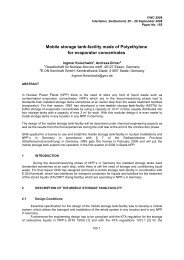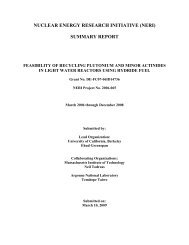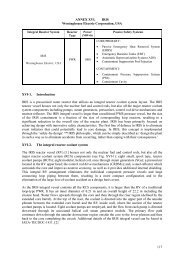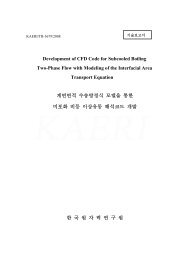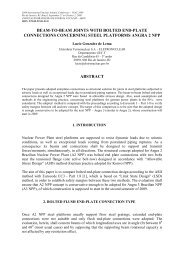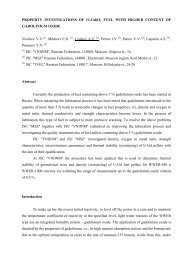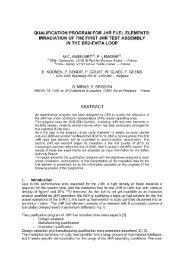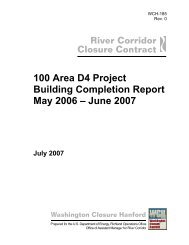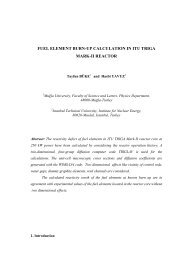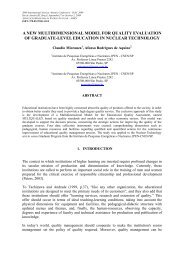Conversion of the WSU reactor to a mixed core of TRIGA- FLIP and ...
Conversion of the WSU reactor to a mixed core of TRIGA- FLIP and ...
Conversion of the WSU reactor to a mixed core of TRIGA- FLIP and ...
You also want an ePaper? Increase the reach of your titles
YUMPU automatically turns print PDFs into web optimized ePapers that Google loves.
3.2. THE <strong>FLIP</strong> FUEL EXPERIENCE AT WASHINGTON STATE UNIVERSITYThomas A. Lovas, Washing<strong>to</strong>n State University<strong>Conversion</strong> <strong>of</strong> <strong>the</strong> <strong>WSU</strong> <strong>reac<strong>to</strong>r</strong> <strong>to</strong> a <strong>mixed</strong> <strong>core</strong> <strong>of</strong> <strong>TRIGA</strong>-<strong>FLIP</strong> <strong>and</strong> <strong>TRIGA</strong>-St<strong>and</strong>ard fuel was undertaken in February, 1976.The <strong>reac<strong>to</strong>r</strong> is <strong>of</strong> General Electric design <strong>and</strong> originally operatedwith MTR-type fuel at a maximum power <strong>of</strong> 100 Kilowatts.In 1967, <strong>the</strong> power output was increased <strong>to</strong> 1 Megawatt <strong>and</strong>pulsing capability was added by a conversion <strong>to</strong> <strong>TRIGA</strong> 20%enriched fuel in four-rod fuel bundles <strong>and</strong> installation <strong>of</strong> anadapted transient rod system. The General Electric reactivitycontrol system consisting <strong>of</strong> three boral control blades <strong>and</strong>one stainless steel servo blade was retained, as were <strong>the</strong> gridplate <strong>and</strong> <strong>core</strong> support structure. The conversion in 1976 <strong>to</strong>70% enriched, 1.5% Erbium loaded <strong>FLIP</strong> fuel achieved <strong>the</strong> objecrives<strong>of</strong> excess reactivity res<strong>to</strong>ration <strong>and</strong> improved fluxlevels in experimental facilities,.Associated with <strong>the</strong> <strong>FLIP</strong> loading, three major modificationswere made <strong>to</strong> <strong>the</strong> control <strong>and</strong> instrumentation systems.The first was <strong>the</strong> addition <strong>of</strong> a fuel temperature scram systemas required by <strong>the</strong> Technical Specifications for operation with<strong>FLIP</strong> fuel. The scram system is based on a Calex Voltsensorfed from Acromag Thermocouple transmitters, providing bothfast <strong>and</strong> slow scram signals. The second modification was ashortening <strong>of</strong> <strong>the</strong> shafts for <strong>the</strong> boral control elements. Theoriginal MTR fuel had, an active fuel, length <strong>of</strong> 24 inches <strong>and</strong><strong>the</strong> control elements were installed <strong>to</strong> provide a 0.5 inch fuelmeat overlap. <strong>Conversion</strong> <strong>to</strong> <strong>TRIGA</strong> fuel with a 15 inch activelength <strong>and</strong> nearly <strong>the</strong> same <strong>core</strong> centerline position resultedin an excessive element overlap <strong>of</strong> 5.0 inches. In order <strong>to</strong>remove <strong>the</strong> negative reactivity addition when elements areinitially withdrawn, <strong>the</strong> shafts were shortened by 4 inches,providing a 1 inch overlap. Subsequent element calibrationsrevealed that <strong>the</strong> reactivity characteristics over <strong>the</strong> firstfew inches <strong>of</strong> blade travel were significantly improved.The third modification was <strong>the</strong> replacement <strong>of</strong> <strong>the</strong> transientrod hold-down device. The hold-down device supplied byGeneral A<strong>to</strong>mic in 1967 had an inside diameter above <strong>the</strong> rod3-21
travel region <strong>of</strong> 1.25 inches, <strong>the</strong> same value as <strong>the</strong> outsidediameter <strong>of</strong> <strong>the</strong> transient control element. A new hold-downdevice was machined by General A<strong>to</strong>mic with an inside diameterthrough <strong>the</strong> <strong>to</strong>p portion <strong>of</strong> 1.3125 inches, allowing <strong>the</strong> controlelement <strong>to</strong> be fully withdrawn <strong>and</strong> removed for inspection withoutcomplete disassembly <strong>of</strong> <strong>the</strong> guide tube <strong>and</strong> hold-down system.Fuel loading commenced February 9, with installation <strong>of</strong><strong>the</strong> three-rod cluster with guide tube for <strong>the</strong> transient rod<strong>and</strong> installation <strong>of</strong> two clusters containing instrumented fuelelements. After operational tests <strong>of</strong> <strong>the</strong> transient rod system<strong>and</strong> calibration <strong>of</strong> <strong>the</strong> fuel temperature systems, loading <strong>to</strong>critical was continued until criticality was obtained with aloading <strong>of</strong> 12 St<strong>and</strong>ard <strong>and</strong> 9 <strong>FLIP</strong> elements. Data collectedduring <strong>the</strong> approach <strong>to</strong> critical experiment is shown in Figure1. Additional elements were <strong>the</strong>n added <strong>to</strong> achieve a fullyoperational <strong>core</strong> loading <strong>of</strong> 9 <strong>FLIP</strong> <strong>and</strong> 19 St<strong>and</strong>ard elementsfor a <strong>to</strong>tal <strong>of</strong> 35 <strong>FLIP</strong> rods <strong>and</strong> 75 St<strong>and</strong>ard rods. Figure 2describes <strong>the</strong> fully loaded <strong>core</strong> including experimental facilities.Upon completion <strong>of</strong> control element calibrations, it wasverified that <strong>core</strong> excess reactivity was $7.98 with a shutdownmargin <strong>of</strong> $2.53. The transient rod worth was determinedas $3.45 over <strong>the</strong> fifteen inches <strong>of</strong> travel. No adjustmentwas made <strong>of</strong> <strong>the</strong> transient element <strong>to</strong> limit <strong>the</strong> travel <strong>and</strong>reactivity worth.Full power tests included measurement <strong>of</strong> <strong>core</strong> temperatures,excess reactivity changes, temperature <strong>and</strong> void coefficients.The relationship between fuel temperature <strong>and</strong> powerlevel for <strong>the</strong> <strong>mixed</strong> <strong>core</strong> is shown in Figure 3, <strong>and</strong> <strong>the</strong> peakindicated fuel temperature at 1 MW during initial full poweroperation was 349°C. The power coefficient <strong>of</strong> <strong>the</strong> <strong>TRIGA</strong>-<strong>FLIP</strong><strong>mixed</strong> <strong>core</strong> without Samarium in <strong>the</strong> <strong>FLIP</strong> region <strong>and</strong> no Xenonwas determined as $2.45 <strong>to</strong> 1 MW. Figure 4 was developed in<strong>the</strong> course <strong>of</strong> a determination <strong>of</strong> <strong>the</strong> temperature coefficient3-22
<strong>of</strong> reactivity, with <strong>the</strong> coefficient ranging from a value <strong>of</strong>-$0.005/°C at low power levels <strong>to</strong> a value <strong>of</strong> -$0.0136/°C atnear peak steady state power levels.The observed value <strong>of</strong>-$0.0136/°C is quite near <strong>the</strong> expected temperature coefficient<strong>of</strong> -$0.014/°C derived in <strong>the</strong> Safety Analysis Report for <strong>the</strong><strong>mixed</strong> <strong>core</strong> conversion.The void coefficient <strong>of</strong> reactivity was measured in <strong>the</strong>wet tube location <strong>of</strong> Core Position C-7.Results indicated anapproximate <strong>core</strong> void coefficient <strong>of</strong> reactivity <strong>of</strong> -$1.42 x10" 2 /7 o void.A summary <strong>of</strong> <strong>the</strong> significant <strong>core</strong> parameters before <strong>and</strong>after <strong>the</strong> conversion <strong>to</strong> a <strong>mixed</strong> <strong>core</strong> is given in Table 1.characteristics <strong>of</strong> <strong>the</strong> <strong>mixed</strong> <strong>core</strong> all compared quite favorablywith <strong>the</strong> expected values given in <strong>the</strong> Safety Analysis Report.During initial full-power operation it was observed thatfluctuations <strong>of</strong> approximately 2% occurred in power level indicationsat power levels between 900 KW <strong>and</strong> 1 MW.Mean powerlevel <strong>and</strong> <strong>core</strong> temperatures maintained quite constant withoutmanual or au<strong>to</strong>matic adjustment <strong>of</strong> reactivity control systems.The power fluctuations have been extensively investigated a<strong>to</strong><strong>the</strong>r facilities fueled with <strong>mixed</strong> <strong>FLIP</strong> <strong>and</strong> St<strong>and</strong>ard <strong>and</strong> all-<strong>FLIP</strong> <strong>core</strong>s with <strong>the</strong> conclusion that <strong>the</strong> disturbance is due <strong>to</strong>2voiding effects <strong>and</strong> poses no operational hazards.The results <strong>of</strong> pulsing tests completed between March 4<strong>and</strong> March 31 for a variety <strong>of</strong> pulsed reactivity insertions aregiven in Table 2.Figures 5 <strong>and</strong> 6 describe <strong>the</strong> pulse output<strong>and</strong> fuel temperatures from a series <strong>of</strong> pulses performed March15.The representative pulse data shown in Figures 5 <strong>and</strong> 6indicate a change in <strong>the</strong> slope <strong>of</strong> each function in <strong>the</strong> neighborhood<strong>of</strong> a pulsed reactivity insertion <strong>of</strong> $2.00.It ishypo<strong>the</strong>sized that <strong>the</strong> inflection in <strong>the</strong> curves reflects <strong>the</strong>complexity <strong>of</strong> temperature, prompt neutron lifetime <strong>and</strong> promptnegative temperature coefficient relationships in a <strong>mixed</strong> <strong>core</strong>during pulses <strong>of</strong> insertion levels greater than $2.00.TheBubble.3-23
formation in <strong>the</strong> fuel region, particularly in <strong>the</strong> contiguousblock <strong>of</strong> <strong>FLIP</strong> fuel, is much more pronounced at insertionsabove $2.00. The formation <strong>of</strong> a greater quantity <strong>of</strong> bubblesis indicative <strong>of</strong> boiling at <strong>the</strong> surface <strong>of</strong> <strong>the</strong> fuel cladding<strong>and</strong> represents a possible shift in <strong>the</strong> heat transfer modeaway from natural convection. The heat transfer characteristicsunder pulsing conditions vary significantly from <strong>the</strong>steady state case <strong>and</strong> are particularly complex in <strong>the</strong> analysis<strong>of</strong> an inhomogenously fueled <strong>core</strong>.A second aspect <strong>of</strong> <strong>the</strong> pulsing performance with <strong>mixed</strong><strong>FLIP</strong> <strong>and</strong> St<strong>and</strong>ard fuel is <strong>the</strong> occurrence <strong>of</strong> power oscillationsin <strong>the</strong> 1 <strong>to</strong> 4 MW range on <strong>the</strong> tail end <strong>of</strong> <strong>reac<strong>to</strong>r</strong> pulses. The3occurrence <strong>of</strong> such oscillations has been reported previouslyin <strong>mixed</strong> <strong>core</strong>s <strong>and</strong> <strong>the</strong> <strong>WSU</strong> experience parallels <strong>the</strong> reportedfindings.The phenomenon may be identified as occurring only afterpulsed reactivity insertions <strong>of</strong> between $2,00 <strong>and</strong> $2.50, <strong>the</strong>license limit. Figure 7 represents <strong>the</strong> post-pulse poweroscillations from data collected by a pho<strong>to</strong>multiplier tube <strong>and</strong>oscilloscope camera recording <strong>the</strong> tail <strong>of</strong> a $2.50 pulse. Thefirst oscillation in <strong>the</strong> pulse tail occurs approximately 0,4seconds after <strong>the</strong> pulse peak is attained <strong>and</strong> is generallyrepeated one or more times by rapid oscillations followed bya final rise approximately 0.7 seconds after <strong>the</strong> initial.Since <strong>the</strong> oscillations only occur in <strong>the</strong> pulse tail <strong>and</strong> atsuch a low power level relative <strong>to</strong> <strong>the</strong> pulse peak, no indication<strong>of</strong> <strong>the</strong> oscillations can be obtained from <strong>the</strong> recordingoscillograph routinely utilized in <strong>the</strong> pulsing mode for peakpower <strong>and</strong> energy release measurement.The characteristics <strong>of</strong> <strong>the</strong> post-pulse oscillations indicatethat <strong>the</strong> oscillations are <strong>the</strong> result <strong>of</strong> voiding effectswithin <strong>the</strong> <strong>FLIP</strong> region associated with film boiling duringhigh reactivity, temperature, <strong>and</strong> power level pulses. Theoscillations do not appear <strong>to</strong> be correlated with <strong>the</strong> peakvalue characteristics described above.3-24
The <strong>the</strong>rmal flux levels in <strong>the</strong> most commonly used experimentalfacilities increased between 257o <strong>and</strong> 307 o as a result<strong>of</strong> <strong>the</strong> conversion. Measurements made with a self-powered neutrondetec<strong>to</strong>r indicated a peak flux <strong>of</strong> ~8.5 x 1012nv in <strong>the</strong>vertical wet tube located in Grid Position D-8. Measurementsin <strong>the</strong> same position prior <strong>to</strong> <strong>the</strong> <strong>core</strong> change revealed a level12<strong>of</strong> ^6.0 x 10 nv at <strong>the</strong> peak. The improvement <strong>of</strong> <strong>the</strong> experimentalfacility flux level met <strong>the</strong> anticipations from preconversioncalculations <strong>and</strong> analysis.Operation <strong>of</strong> <strong>the</strong> <strong>reac<strong>to</strong>r</strong> since initial startup with <strong>the</strong><strong>mixed</strong> <strong>core</strong> has <strong>to</strong>talled only forty megawatt-days. The rate <strong>of</strong>excess reactivity loss over this operating period has beencalculated at $0,011 per megawatt day, reflecting <strong>the</strong> accumulation<strong>of</strong> primary poisons in <strong>the</strong> <strong>FLIP</strong> fuel. More data fromcontinuing operations will be necessary <strong>to</strong> determine an equilibriumrate <strong>of</strong> excess loss.In summary, <strong>the</strong> observed performance <strong>of</strong> <strong>the</strong> <strong>mixed</strong> <strong>core</strong>has been quite satisfac<strong>to</strong>ry <strong>and</strong> analysis has indicated nosignificant deviations from <strong>the</strong> design predictions <strong>and</strong> specifications.No major operational problems have developed since<strong>the</strong> conversion was completed.3-25
Table 1:<strong>WSU</strong> Reac<strong>to</strong>r CharacteristicsAll-Stam dardMixed <strong>FLIP</strong>-StdExcess reactivityShutdown marginPower coefficientPrompt neutron lifetimeTemperature coefficient(per °C)Void coefficient(per % void)Pulse peak power($2.50 addition)Maximum indicatedfuel temperature($2.50 addition)Available <strong>the</strong>rmal flux(axial average nv, D-8)$6.03 $7.98$5.54 $2.53$3.20 $2.4539 usee 28 usee-$1.71 x io- 2 -$1.36 x 10" 2-$1.31 x 10" 2 -$1.42 x 10" 2970 MW 1850 MW347°C 449°C5.6 x 10 12 6.17 x 10 12Table 2: Pulse Data, 3/4-31/76p, $ No. <strong>of</strong> PulsesAvg. PeakFuel Temp., CAvg. PeakPower, MW1.10 2 235.5 7.111.15 1 248.0 16.591.25 3 271.7 60.001.50 6 309.3 155.301.75 4 333.8 304.802.00 3 367.3 622.302.25 3 403.0 1197.302.50 11 442.4 1850.503-26
1.0Figure 1:Approach <strong>to</strong> Critical Experiment Core 30AInverse multiplication vs. fuel rod addition+->03i.0.8-0.6-C3Oo .0.4 _Blades in0.2BladesoutAB1CIC#2/T20"T40 60Fuel Rods InstalledFigure 2:<strong>WSU</strong> <strong>TRIGA</strong> Core Layout2 3 4 5 6 7 R/ / / / / /S s s S SC S S sir F F - IDEFG/s\ )9-ission>hmbrS S F IIF JJ F so 0s S F F F s/7S S S S s/GammaCICChmbr © /m / / / / #1*Control Element"T80TSm©mInstrumentedJT|wlRota<strong>to</strong>rTube100FliD orSt<strong>and</strong>ardFuel BundleReflec<strong>to</strong>rElementRabbitNeutronSourceFuel RodTransient RodWet Tube3-27
Figure 3:Fuel Temperature vs.Power Levelf T —I-200 400 600Power, KW8001000Figure 4:Average Temperature Coefficient vs,Average Core Temperature"TOO 200Average Fuel Temoerature, °Cm3-28
2000500-Figure 5:Peak Indicated FuelTemp vs. Reactivity Insertion301Figure 6:Peak Power <strong>and</strong> EnergyRelease vs. ReactivityInsertion* 1500-aOJIN3«3oo1)5400'S-
2.4-1Figure 7:Post-Pulse Power Oscillationsu>Ios-cu3:oQ_S_o-t->ures
References1. Amendment I_ tc> Safety Analysis Report <strong>of</strong> Oc<strong>to</strong>ber, 1966.Washing<strong>to</strong>n State University, Nuclear Radiation Center,Pullman, Washing<strong>to</strong>n. May, 1974.2. R<strong>and</strong>all, J. D. , e_t al. , "A Study <strong>of</strong> Power Fluctuationsin a <strong>FLIP</strong> Fuel Reac<strong>to</strong>r using <strong>the</strong> Technique <strong>of</strong> NoiseAnalysis," Texas A&M University, in Papers <strong>and</strong>Abstracts, <strong>TRIGA</strong> Owners' Conference III, 1974.3. Schumacher, R. F., et al., "Post-Pulse Power Oscillationsin a 35 <strong>FLIP</strong> Element, Mixed <strong>TRIGA</strong> Core," <strong>TRIGA</strong>Owners' Conference IV, 1976.3-31



